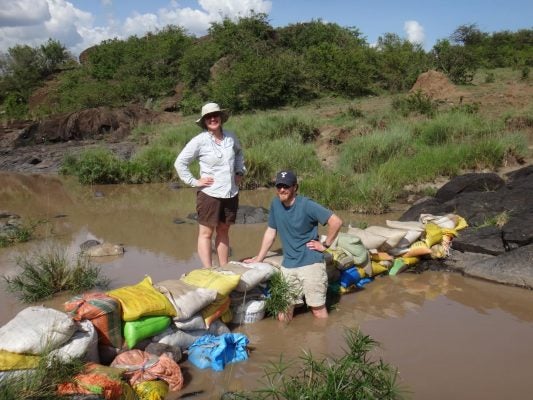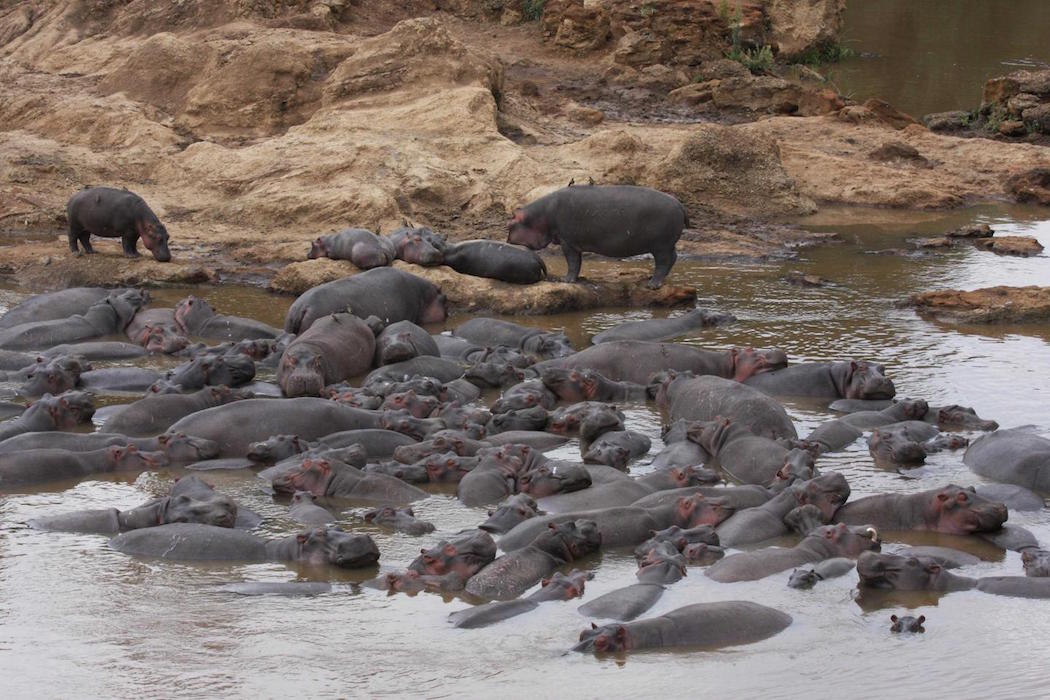Hippopotamus excrement is such a potent aquatic life killer, fish just don’t stand a chance. But that may not be a bad thing.
A few years ago, a group of ecologists studying the Mara River’s flow in the Maasai Mara National Reserve of Kenya was approached by the local tribe. The concerned Maasai people wanted to know what caused the recurrent mass fish die-offs in their river. Ecologist Cheryl Lyn Dybas writes that the Mara River is a key player in the local ecosystem, supplying water to wildlife, people, livestock, and crops. Seeing periodic batches of fish floating belly up in the Mara’s currents was a frightening scene. The Maasai suspected that pesticides trickling into the river from the upstream farms were to blame. It turned out, hippos were the culprits. Their excrement was giving the river inhabitants a toxic shock—on a weather-related schedule.
Maasai Mara National Reserve of Kenya is home to over 4,000 hippos that graze in the savanna at night and hang out in the river’s shallow pools to keep cool during the day. As they wallow in the water, they excrete waste— about 9.3 tons a day of partially digested plant material akin to the grass clippings you get when you mow your lawn. All of that ends up in the relatively small pools they favor, settling to the bottom as soft sediment.
That partially digested organic matter contains a lot of carbon, which bacteria in the water begin to decompose as an energy source. As they break down the carbon, bacteria also consume oxygen in the river, wrestling it out of various oxygen-containing compounds.

Eventually the water becomes anoxic (devoid of oxygen), explains Christopher Dutton, an aquatic ecologist at Yale’s Department of Ecology and Evolutionary Biology. “Once you get to that anoxic state you also have microbial byproducts,” such as hydrogen sulfide or ammonia, which are toxic to fish. Bacteria also produce methane. “The methane displaces the oxygen and the fish becomes sort of drunk on methane,” Dutton says.
These anoxic, toxic pools are time bombs that finally go off after a heavy downpour. The surge of water flushes the pools out and sends all that hippo sewage sludge downstream. When these flush-outs occur, two things happen: First, the low-oxygen water from hippo pools mixes with the fresh, excrement-free water, reducing the river’s overall dissolved oxygen concentration; next, when the accumulated sediments in the hippo pools wash out into the river, the bacteria in them continue to use up oxygen as it decomposes the organic matter in the river currents. “During dry periods, oxygen-poor water accumulates in hippo pools,” says Emma Rosi, a freshwater ecologist at the Cary Institute of Ecosystem Studies. “Periodic intense rains eventually flush the water downstream. This sudden pulse of deoxygenated water can cause temporary hypoxia and fish kills.”

To understand this phenomenon, researchers spent three years studying water flow and chemistry in 171 hippo pools. The team also built bathtub-sized artificial streams and a dam on the Mara River to produce a test flush flow. Because hippos are too dangerous for humans to approach, the team did a lot of work with an information-gathering boat robot.
Built by Platypus, a company that specializes in aquatic data collection, the boat swam around the pools carrying various sensors and measuring the water temperature, depth and the type of sediment deposits. To avoid attracting too much attention from the hippos, the team disguised the boat as a crocodile—which hippos tend to ignore. Platypus’s creator Paul Scerri explains that the boat essentially wore a crocodile mask—and that did the trick. “The hippos didn’t mind the boat too much,” Dutton says. “We only had it chased by a hippo once. Usually they just kind of watch it from a distance.”
Fish kills may sound like a disastrous event, but scientists found that they serve a purpose within the ecosystem. The dead fish provide a food source for scavengers like birds and crocodiles who devour the carcasses within a day or two.
The team’s discovery helped solve the mystery of the periodic fish kills. It put the Maasai tribe, which historically acted as the stewards of the ecosystem, at ease. But it also led to a new understanding of the river ecology. Ecologists tend to think about rivers as pristine bodies of water that don’t have periodic oxygen depletion events, but that’s likely not how it was before humans decimated wildlife in certain parts of the planet. The team thinks that these fish die offs are a natural phenomenon that researchers missed. “We think this is because generations of scientists have studied places that no longer have intact large wildlife populations, whereas the Mara River is unique because it does,” Dutton says. “This system offers a window into the past and illustrates how ecosystems might have functioned before human impacts.”







